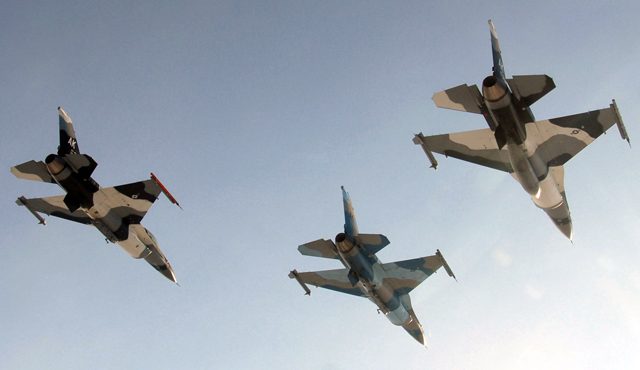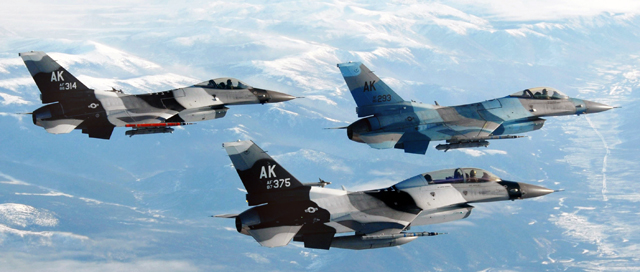The US Air Force is hoping to upgrade its fleet of Lockheed Martin F-16 Fighting Falcon "aggressors" so that those aircraft can better replicate enemy fighters, the service's Air Combat Command (ACC) says.
"To date, generally, it is considered that the aggressors under-replicate the current threat," says Major Gary Barker, the ACC training operations division's F-16 functional area and realistic training manager. "It's very difficult for the aggressors to provide the threat picture that we think we would see in near-peer combat."
In an effort to rectify the problem, ACC hopes to upgrade the older Block 30 and 32 F-16s used by the 18th and 64th Aggressor Squadrons to the System Capabilities Upgrade-8 (SCU-8) configuration, Barker says. SCU-8 will allow the USAF to incorporate a helmet-mounted cueing system and a new center display unit, which Barker describes as having functionality similar to an Apple iPad.
"With that, you can simulate missile WEZs [weapons employment zones] and provide more accurate cueing real-time that can aid in kill removal and weapons assessment airborne," Barker says.
 |
|---|
USAF |
Right now, when an aggressor F-16 is replicating an enemy fighter like a Sukhoi Su-30 Flanker, it does not have an onboard system to simulate a weapon like the Vympel R-73 (NATO: AA-11 Archer). "We do not have an IR [infrared] weapon on the aircraft that is similar to an Archer," Barker says. "So the F-16 pilot will use visual references that he has memorized to determine when the adversary airplane is in range and within the appropriate look angle."
Using the current configuration, there is no electronic system that tells the aggressor pilot if he is within the correct parameters for a valid missile shot. The shots have to be reviewed on the ground to ensure they are valid--even if they are called in real time during the training sortie. But the current system does not work well. "Without a helmet--or at least a 9X CATM [Captive Air Training Missile]--the pilots have to basically spit-ball the threat WEZ and it is highly inaccurate," one highly experienced USAF pilot says, "So inaccurate that the feedback for training is useless most of the time."
The addition of the center display and Joint Helmet-Mounted Cueing System should enable the aggressor pilots to more accurately assess their missile shots in the air, Barker says.
The USAF is also hoping to incorporate higher quality training pods for the aggressors which would provide better electronic attack (EA) threat replication, Barker says. "The advanced fighter aircraft that are out there with their weapons and their EA is a continuing problem-to be able to do that accurately," he says.
The problem for the USAF is funding, especially in these difficult fiscal times. "That, what I spoke to earlier, is the plan," Barker says. "Securing funding to be able to execute that plan is a separate topic. Nothing is guaranteed right now."
While the current F-16 and F-15 aggressor aircraft are well-suited to replicating fourth-generation fighter threats such as the Sukhoi Su-30MKK Flanker-G, they are probably not going to be able to provide a realistic threat presentation of future adversaries like the Chinese Chengdu J-20 and Shenyang J-31 or Russian Sukhoi PAK-FA. However, it is not a problem the USAF is immediately concerned with.
"Right now there is clearly little known about the capabilities and operational timeline for the adversary stealth threat," Barker says. "So it is not appropriate for the aggressors to replicate threats that are not fielded or near fielding."
 |
|---|
USAF |
Barker says he is not sure how the USAF will address the problem of replicating enemy fifth-generation stealth fighters. "It very likely will be a problem," he says. "But determining the scope of that problem, to assess how much resource we should put towards replicating it-we're just not there yet."
In the future, Barker says that it is likely that realistic training for the Lockheed Martin F-22 and F-35 will have to be provided in simulators. But there will still have to be live training on the ranges-though the difficulty level will have to be ratcheted up significantly. "We are still working through the best balance there between live fly and simulated training events," Barker says.
Another possibility is live virtual constructive training where computer generated targets are fed into the avionics of real aircraft flying over real world ranges. However, Barker notes that a number of range safety and air traffic management issues need to be solved before such a system could be used for routine operational training. "For safety of flight reasons, it's still not a mature concept," he says.
The only real option for a future live aggressor aircraft is probably going to be the F-35. But using the F-35 as an adversary could be problematic. "The F-35 would be incapable of replicating quite a few adversaries," Barker says. "It's very difficult to replicate a non-stealthy airplane with a stealthy airplane, though it probably would not be the sole platform if we ever got to that point."
Source: Flight International
















